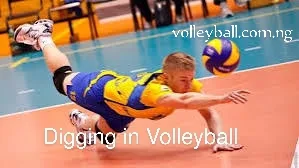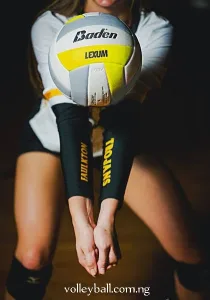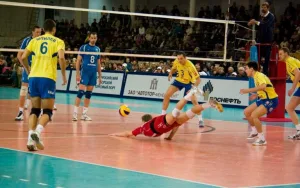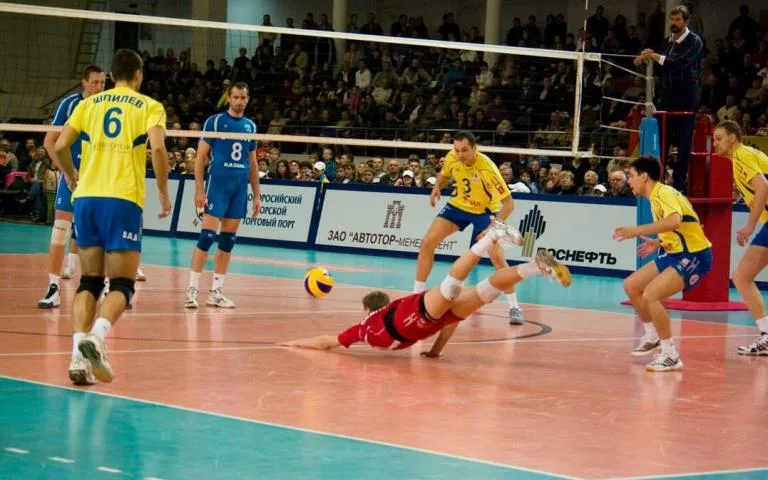What is a dig in volleyball? Digging in volleyball is one of the best skills that any winning team must master. For any defensive specialist or back-row player, mastering the dig is essential to maintaining control of the game.
Digging in volleyball is a defensive technique used to prevent the ball from touching the court after an attack by the opposing team.
In this article, we’ll answer this question, “What is a dig in volleyball?” and also explore all the important information about volleyball digging, the importance of digging, digging techniques, and skills needed for proper digging in volleyball.
What is a Dig in Volleyball?

Like we mentioned previously, a dig in volleyball refers to a defensive move where a player prevents the ball from touching the court after it has been attacked by a spike. One of the main reasons for volleyball digging is to control the ball by absorbing the power of the spike and keeping it in play, allowing the team to set up an offensive counterattack.
Why is digging important in volleyball?
Digging is very important in volleyball because it is one of the professional defensive approaches in volleyball. Volleyball digging is important in the following volleyball aspects:
- To prolong rallies, giving the attacking team more opportunities to score.
- To neutralize powerful attackers, frustrating opponents and forcing them into errors.
- To build or shift momentum to energize and boost the team’s morale.
How Digging in Volleyball Works?
To understand how digging works in volleyball, we need to break it down to a layman understanding of terms:
1. Reading the play:
In digging, the defender will have to anticipate the trajectory of the attacking team’s spike or hit by reading or predicting the play.
2. Positioning:
After reading the play, the defender will then have to position himself in the correct spot to make a play on the ball.
3. Timing:
After proper positioning, the defender then waits for the right moment to dive or reach out to make contact with the ball.
4. Contact:
Contact happens when the defender makes a move after proper timing by using their hands or arms to make contact with the ball to keep it from touching the ground.
5. Control:
After a successful contact, the defender aims to control the ball, either by keeping it in play or directing it to a teammate.
See Also: What is a DS in Volleyball? Defensive Specialist Explained
How to Have a Great Volleyball Dig
1. Proper stance and positioning

One of the most important approaches to having a great dig starts with your positioning. A proper stance and positioning enable you to move quickly in any direction and react to the ball. To achieve a good stance and positioning, you should practice the following:
- Your body should be low, with your knees bent, shoulders forward, and weight balanced on the balls of your feet. This athletic stance allows you to move in any direction at a moment’s notice.
- Your feet should be positioned shoulder-width apart to maintain stability and quick lateral movement.
- Extend your arms slightly in front of you, with your hands apart but ready to come together quickly to form a platform.
2. Reading the Attack
Reading the attack involves proper anticipation and interpretation of the offensive team’s strategies and the individual attacker’s intentions. It involves recognizing patterns, cues, and body language to predict where and how the attacker will hit the ball.
How to:
- Focus on the Attacker: Good defenders read the hitter’s approach, arm swing, and contact point to predict the direction of the ball.
- Watch the Setter’s Cues: The setter’s body position and the angle of the set can provide clues about where the spike will go.
- Stay Low: A lower body position allows quicker lateral movement and better absorption of power from hard-driven balls.
3. Executing the Dig
When the ball is coming your way, it’s time to execute.
How to:
- Form a Solid Platform: Bring your forearms together to create a flat, firm platform. Keep your wrists and elbows locked to control the ball’s rebound.
- Absorb the Impact: Slightly lower your body as you make contact with the ball, using your legs to absorb the ball’s power rather than letting your arms take the full force.
- Angle the Platform: The angle of your arms will determine the direction of the ball. Typically, you want to aim upward towards the setter or a designated player.
- Follow Through: After making contact, stay balanced and be ready to move for the next ball. Digging isn’t just about stopping one hit; it’s about staying engaged in the play.
See Also: Volleyball Ready Position: What is it’s and how is it used?
Types of volleyball digs
There are different kinds of digs in volleyball. Volleyball digs depend on the situation and the nature of the spike the defender is defending against.
1. The Basic Dig
The basic dig is a kind of volleyball dig that is performed when the spike comes at a manageable height and power. This is the most common type of dig, and it involves positioning correctly to create a solid platform and guide the ball upward.
2. The Pancake Dig
The pancake dig is usually regarded as the last resort technique. This volleyball digging technique is usually used when the ball is about to hit the ground and the player slides their hand flat against the court in a desperate attempt to keep the ball in play.
3. The One-Arm Dig
The one-arm dig is a volleyball digging technique that is usually used in situations where the player cannot position both arms in time. This type of volleyball digging requires more precision and control, as only one arm is used to direct the ball back into play.
4. The Diving Dig
The diving dig is a type of volleyball dig that involves diving to execute a dig. This kind of digging usually occurs when the ball is out of immediate reach, which causes the player to dive to execute the dig.
In diving, the player launches themselves in the direction of the ball, landing flat on their stomach or side while still focusing on making contact with the ball.
See Also: Famous volleyball players in 2025
Common Volleyball Digging Mistakes and how to avoid them?
Over the years, a lot of volleyball players have made a lot of volleyball digging mistakes. In fact, even professional players make mistakes when digging. To avoid these mistakes, it’s important we draw your attention to these mistakes and recommend possible ways to avoid or correct them:
Mistake 1. Standing Too Tall
When volleyball players stand upright, they are less able to move quickly or absorb the ball’s power, and this can result in poor digging. To avoid this, always maintain a low and athletic stance.
Mistake 2. Improper Arm Positioning
If your arms are too high or too low, it can lead to poor ball control. To avoid this kind of mistake, aim to keep your forearms flat and your elbows locked during contact.
Mistake 3. Poor Anticipation
Failing to read the attacker or the set can leave you out of position. To avoid this, always watch the ball and the attacker closely to improve your reaction time.
Mistake 4. Overreaching
Reaching for the ball rather than moving your feet leads to off-balance digs and loss of control. Prioritize getting your body behind the ball.
See Also: Mastering Volleyball Approach Footwork: The 3-Step Technique
What is a Dig in Volleyball: Frequently Asked Questions About Digging in Volleyball?
1. What is the difference between a dig and a pass in volleyball?
A dig is a defensive move that occurs when a player saves the ball from an attack (such as a spike) and keeps it in play. The goal of a dig is to control the ball, usually directing it to the setter for the next play. A pass, on the other hand, typically refers to the first contact made after a serve. It’s often called a “bump,” and its purpose is to get the ball to the setter, not necessarily to defend an attack.
2. How can I improve my digging technique?
To improve your volleyball digging technique and accuracy:
- Focus on staying low in your stance and maintaining balance.
- Practice quick footwork to be in position for the ball.
- Keep your forearms straight and form a solid platform to absorb the ball’s impact.
- Use specific drills like partner pepper, wall digs, and reaction drills to enhance your skills.
- Watch the hitter to predict where the spike is going, allowing you to move early.
3. What position in volleyball is responsible for digging the most?
The libero and defensive specialists are primarily responsible for digging. These positions are focused on defense and are often placed in the back row to receive spikes and hard-driven balls from the opposing team. However, all back-row players are involved in digging when needed.
4. How do you properly execute a pancake dig?
A pancake dig is performed by sliding or diving and extending one hand flat on the ground just before the ball hits the floor. The goal is to have the ball bounce off the back of your hand, keeping it in play. It’s a last-ditch effort and should only be used when you can’t get under the ball with both arms to create a platform.
5. How do you absorb the impact of a hard spike when digging?
To absorb the impact of a hard spike:
- Position yourself low with knees bent to help your body act like a spring.
- As the ball makes contact with your forearms, bend your legs slightly and let your knees absorb the power.
- Keep your arms firm and locked to avoid the ball bouncing off uncontrollably.
6. What are some common mistakes made during digging?
Some common digging mistakes include:
- Standing too upright: This reduces mobility and reaction speed.
- Incorrect platform positioning: Poor arm placement leads to inaccurate digs.
- Reaching instead of moving: Failing to move your feet results in off-balance digs.
- Improper ball tracking: Not watching the hitter or ball closely can leave you out of position.
7. Is digging more difficult than receiving a serve?
Digging can be more difficult than receiving a serve because spikes typically come at faster speeds and more unpredictable angles compared to serves. A spike also involves more force, so the player must focus on absorbing the power, maintaining control, and keeping the ball in play. However, both skills require strong fundamentals, quick reactions, and proper positioning.
8. What are some drills to improve reaction time for digging?
Drills that help improve reaction time for digging include:
- Partner pepper drills: Practice digging back and forth with a partner using controlled hits.
- Random ball placement drills: Have a coach or teammate hit balls to random spots on the court to work on quick footwork and reaction.
- Wall dig drills: Continuously dig the ball against a wall, focusing on fast adjustments to the ball’s rebound.
- Short-distance reaction drills: Stand close to a hitter who performs quick spikes, forcing you to react instantly.
9. Can you dig a volleyball with one hand?
Yes, you can dig with one hand, but it requires a lot of precision and control. One-arm digs are typically used in emergency situations when you can’t position both arms to create a platform. It’s important to angle your hand and arm properly to keep the ball in play. However, two-handed digs using a solid platform are more reliable and controlled.
10. How should I communicate with my teammates during a dig?
Effective communication is critical for digging and overall defense. As a defender, you should:
- Call for the ball by saying “mine” or “got it” if the ball is coming to you.
- Let teammates know when you’re covering their area if you anticipate a difficult spike.
- After digging, shout instructions to help guide the setter or next player in line.
Read more:
- 9 Best Volleyball Drills for High School Boys
- Volleyball Hitting Drills: Improve Your Spike, Power, and Accuracy
- Volleyball Passing Drills
What is a Dig in Volleyball: Conclusion

A dig in volleyball is one of the most important defensive techniques used to prevent the ball from touching the court after an attack by the opposing team. So mastering the dig is one of the most important skills for any volleyball player, especially those in defensive positions like the libero or defensive specialist.
You can achieve and improve your digging skills through consistent practice, anticipation, and coordination. You can become a reliable digger who keeps your team in the game during high-pressure moments, and this can bring victory to your team.




